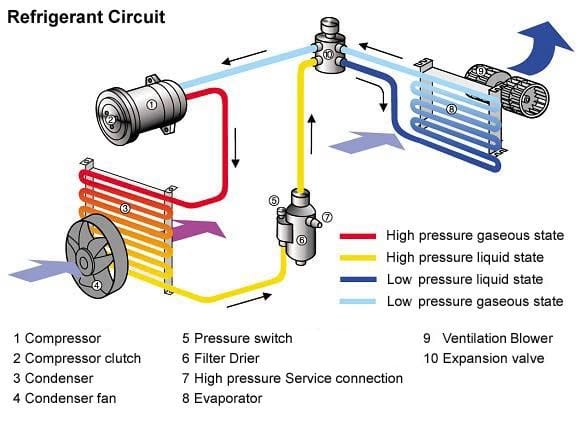It’s your saving grace in the heat of Summer, but have you ever wondered how your car’s air conditioning system works? Your car’s air conditioning system is made up of hundreds of components including hoses, valves, sensors, switches, pumps, filters, fans, that’s really just to name a few.
Today we’re going to run through the major components of your vehicle’s air conditioning system and show you how they work together to keep your car cool.
Here is how your car’s air conditioning system works…
So, let’s begin with the hardest working component of the system the AC compressor. The compressor is the workhorse of the car air conditioning system. When the air con system is turned on, the compressor pumps refrigerant vapour under high pressure to the condenser.
So, next down the line is the condenser, this one here. It’s a device used to change the high-pressure refrigerant vapour to a liquid. The vapour is condensed to a liquid because of the high pressure that is driving it in and this generates heat. The heat is then in turn removed from the condenser by air flowing through the condenser on the outside.
After the condenser, the liquid refrigerant moves into a receiver dryer. The receiver dryer acts as a filter for the liquid refrigerant. It removes any moisture and other contaminants that may have leaked into the refrigerant. The pressurised refrigerant flows from the receiver-drier to the expansion valve or TX valve. The expansion valve removes pressure from the liquid refrigerant so that it can expand and become refrigerant vapour in the evaporator.
As cold, low-pressure refrigerant is passed through into the evaporator, it vaporises and absorbs heat from the air in the passenger compartment. The blower fan inside the passenger compartment pushes air over the outside of the evaporator so cold air is circulated inside the car.
And now we’re basically back to where we started with the compressor. At this point, the compressor draws in the low-pressure refrigerant vapour to start another refrigeration cycle. The refrigeration cycle then runs continuously and is regulated by the setting of the expansion valve.
Another important component of your air conditioning system is the cabin filter, also known as a pollen filter. This filters the air that is blowing into the cab of the vehicle. Often when there are bad smells or poor air flow coming from your air conditioning, it is because of a blocked or dirty cabin filter.
Finding Faults
As we mentioned at the start of the video, the air conditioning system is made up of hundreds of components which can make it difficult to diagnose a fault. Especially if we don’t know exactly what we’re looking for. This is why we always include a UV dye as part of our standard air conditioning service. This ensures that if there ever is a leak in your AC system, we are able to identify where it is and repair or replace the part as needed.
If your Car’s AC system isn’t working as well as it used to, we have another video on checks that you can do at home that you can learn more about here.
Remember, when dealing with your car’s AC system here in Australia, the industry’s governed by ARCTick and all technicians should be licenced.
If you have any questions about your car air conditioning system, you can give us a call on 1300 227 353, comment below or drop us an email to info@amae.net.au.

